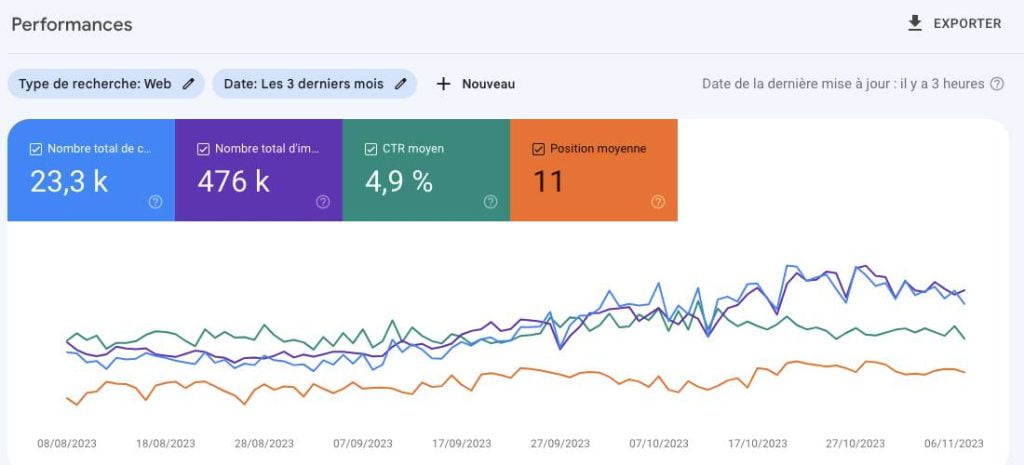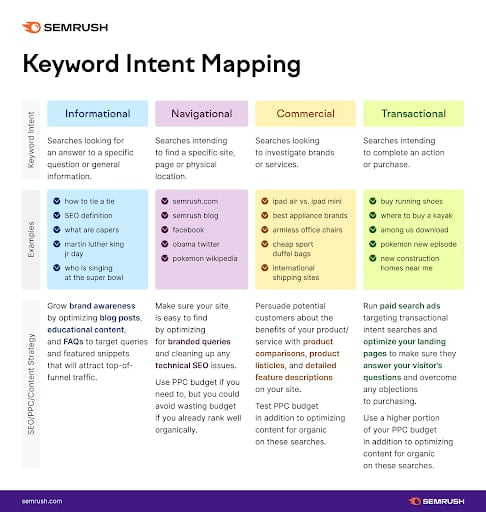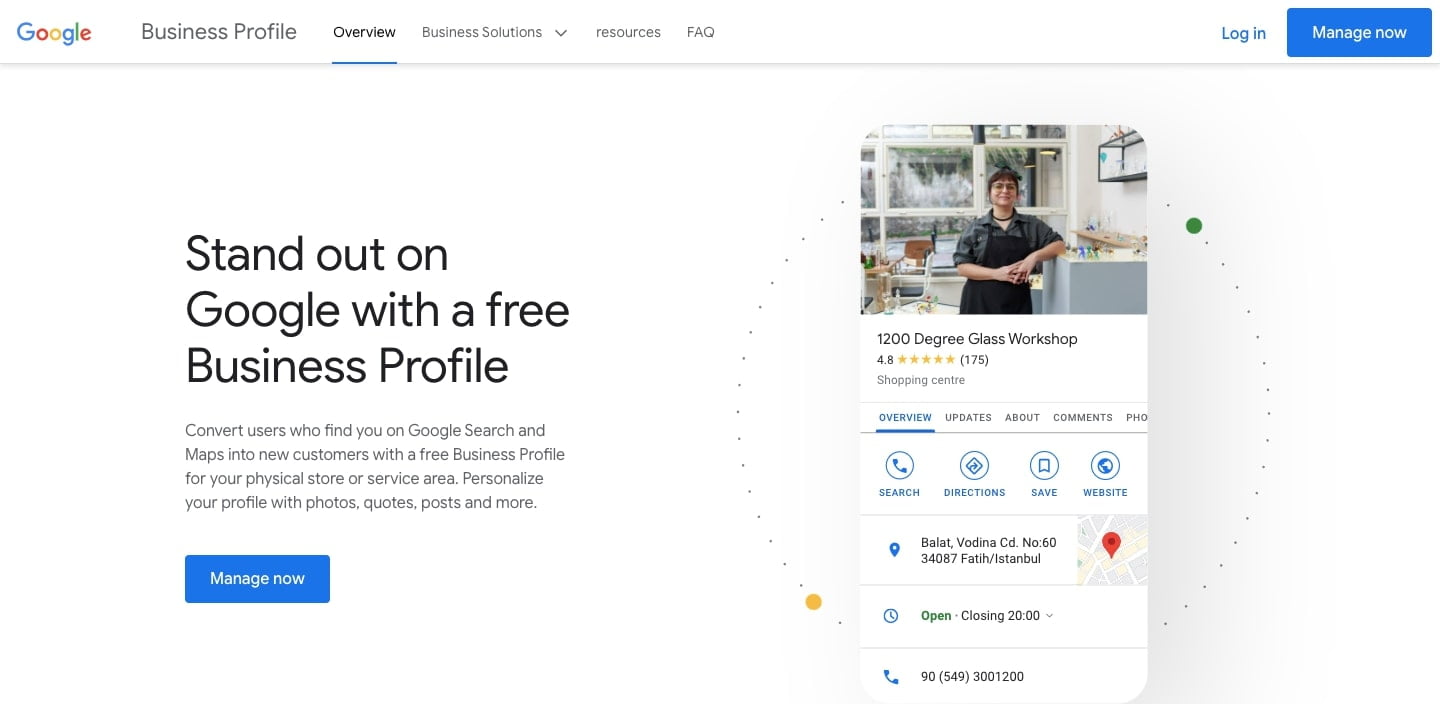Appearing on the first page of Google is essential for any business looking to increase its online traffic and visibility. Positioning your business on the first page of Google allows you to attract qualified traffic and enhance the credibility of your brand. Internet users tend to trust websites that appear at the top of search results.

Therefore, your company’s SEO strategy should be focused on achieving this top position. It is a complex task that requires a deep understanding of Google’s algorithms. Achieving this goal requires constant attention to the latest SEO trends. In this article, we will provide you with 11 tips to help you reach this objective. The SEO strategy must imperatively aim to be on the first page of Google in 2024.
Summary:
- Indexing your site on Google
- Implementing a keyword strategy
- Producing quality content optimized for Google
- Optimizing meta tags
- Using AI to generate original images
- Making your site mobile-friendly
- Internal linking of your pages
- Increasing domain authority with backlinks
- Creating your establishment listing on Google Business Profile
- Being present on Google through social networks
- Improving your website’s speed
1- Indexing Your Site on Google
You have meticulously designed and optimized your website. You are now ready for your customers and prospects to discover your site whenever they perform a relevant search. However, if you have just created or redesigned your site, Google may not be aware of its existence. To appear on the first page of Google, it is imperative that your site is present and indexed on Google.
How to check if my site is indexed on Google?
- Enter the command site:yourdomain.com in the Google search bar to see all indexed URLs.
- Enter the command site:yourdomain.com/exact-URL to check if a specific URL is indexed.
If your website does not appear in Google’s list, you need to request the indexing of your site. You have two options:
- Use the URL inspection tool on Google Search Console for a few URLs.
- Submit a sitemap to facilitate the indexing of many URLs.

Monitoring Your Website’s Position on Google Search Console
Verify the relevance of the web page content. To appear in Google search results, your web page must be relevant to the searched keyword. Make sure your content is related to the keyword; otherwise, Google is unlikely to display your page in its search results.
It is also essential to understand the importance of keyword diversity. Integrate synonyms of your main keyword, long-tail keywords, and other terms closely related to your topic. This strategy will increase the relevance of your content and optimize your visibility to position yourself on the first page of Google.
Monitoring Your Website’s Position on Google
Regularly monitoring the position of your website on Google is crucial. The goal is to assess the effectiveness of your SEO strategy and make necessary adjustments. By monitoring your position, you can identify keywords for which you are well-ranked and those that require more effort. You can also detect fluctuations in your ranking and deduce possible causes. This approach will allow you to continuously optimize your SEO strategy to improve visibility and achieve ranking goals. Here are some tools to monitor your site’s position on Google:
- Google Search Console
- Semrush
- Ahref
2- Implementing a Keyword Strategy
At the heart of any effective SEO strategy is a careful selection of the best keywords. It is essential to choose keywords that are not only relevant to your content but are also likely to be used by your target audience when searching. This requires a deep understanding of your subject and audience. Moreover, it is important to consider the semantic field around your keywords. This means including synonyms, long-tail keywords, and other terms related to your topic.
The use of Hn tags is also essential in optimizing page content. These tags organize your page’s content into hierarchical sections. Not only do they improve the user experience by making your content easier to read and understand, but they also help Google understand your page’s structure. Hn tags are an excellent place to include your keywords, as Google uses them to understand your page’s content.
Finally, meta tags play a crucial role in how Google explores and indexes websites. Meta tags provide information about your page’s content to Google and other search engines. A well-written meta tag can improve your site’s visibility and increase click-through rates. Therefore, it is essential to optimize your meta tags by including your keywords and writing compelling text that encourages users to click on your site in search results.
3- Producing Quality Content Optimized for Google
To rank your site well on Google, it is essential to produce original and quality content. Website content plays a crucial role in SEO. Google favors sites that offer unique, relevant, and informative content. Therefore, it is important to ensure the quality of your content, optimize it for relevant keywords, and update it regularly. Moreover, original and well-written content is more likely to attract and retain visitors, which can increase the time spent on the site and improve your ranking on Google.
Using moderately AI for Content Generation
In practical terms, Google’s perspective has not been radically altered by the sudden popularity of ChatGPT. However, it is important to note that the search engine giant has recently updated its help page for creating quality content. A section named “Who, How, and Why” has been added to guide creators.
Google concludes its discourse by addressing 10 SEO questions
Here is a summary of what to remember:
- The appropriate use of AI is not in contradiction with Google’s guidelines.
- Google does not globally prohibit AI-generated content as this method can create interesting content.
- The search engine is capable of detecting low-quality content, whether generated automatically or not.
- To prevent the spread of misinformation, Google applies the same principles but is even more vigilant about quality
- Google uses various systems, including SpamBrain, to analyze signals and identify content created to manipulate rankings.when it comes to health, political, or financial information.
- The content creation process is not central for Google. The search engine analyzes quality to determine an appropriate ranking.
- You can use AI to create useful and original content. AI should not be seen as an easy and inexpensive way to rank well.
- You must indicate the author of content when users may wonder who wrote it. The search engine reminds that articles referenced on Google News must be signed. Between the lines, we understand Google’s cautious stance on the role of AI in the press.
- The engine advises indicating that content was created automatically when users can reasonably wonder who wrote it.
- Finally, Google specifies that “giving an author’s signature to AI is probably not the best way to follow [its] recommendations.”
In summary, the use of AI for content generation is accepted by Google if it is used with the goal of creating quality, useful, original, and complete content. That being said, nothing prevents Google from evolving its position on this subject in the future.
Creating Targeted Content Meeting Search Intent
When creating content, it is essential to align it with the user’s search intent and provide a concrete answer. Search intent refers to the goal a user has in mind when formulating a query in a search engine. Generally, four categories of search intent are distinguished:
- Informational: The user wants more information, for example, when searching for “Shoes.”
- Navigational: The user is looking for a specific website, such as searching for “Nike official website.”
- Transactional: The user intends to make a purchase, for example, when searching for “Buy running shoes online.”
- Commercial investigation: The user is in the research phase before making a decision, for example, searching for “Best running shoes 2024.”

To meet search intent, it is essential to analyze the type of queries users make and adapt your content accordingly. Google aims to provide the best answer to the user’s question. By producing content that aligns with search intent, you increase the likelihood of ranking well on Google.
The length of your content can impact its performance on Google. While there is no fixed rule, longer content often provides more in-depth information and is perceived as more valuable. However, it is crucial to prioritize quality over quantity. Your content should be engaging, informative, and directly address the user’s query.
Google advises referring to its content quality communications, particularly its EEAT concept:
- Expertise
- Experience
- Authority
- Trust
These four words encapsulate the criteria to adhere to when creating content that Google values
4- Optimizing Meta Tags
Meta tags are snippets of code that provide information about a web page to search engines. They are not visible on the page itself but play a crucial role in SEO. There are several types of meta tags, but the most important ones for SEO are:
- Title Tag: This is the title of your page and appears as the main headline in search engine results. It should be concise, include your target keyword, and encourage users to click.
- Meta Description: This is a brief summary of your page that appears below the title in search results. It should be compelling, include relevant keywords, and entice users to click through to your site.
- Header Tags (H1, H2, H3, etc.): These tags structure the content on your page. The H1 tag is usually the main heading and should include your target keyword. Subheadings (H2, H3, etc.) can also include variations of your keyword and help organize your content.
Optimizing these meta tags helps search engines understand the content of your page and improves your chances of ranking higher.
5- Using AI to Generate Original Images
To generate original images, the use of artificial intelligence (AI) has become increasingly accessible. Several AI tools and libraries are available, including DALL-E, Midjourney, and Stablediffusion. These tools allow for personalized image creation by selecting a style, visual elements, and adjusting color and size. Once preferences are defined, the AI generates an image that you can then refine or edit.
Google is responding to the rise of image generators. In a recent blog post, the company announced the deployment of its AI-based image generator within Google search, exclusively reserved for users enrolled in the Search Labs program for the Search Generative Experience. Currently, Google favors original creations generated by AI over stock image banks. Using AI-generated images increases your chances of appearing on the first page of Google compared to using images from sources like iStock.
The use of AI for generating original images can be an effective means of creating visual concepts, prototypes, or exploring new visual ideas. Additionally, each tool may offer specific features, so it’s important to explore them and choose the one that best suits your creative needs.
6- Making Your Site Mobile-Friendly

To make your website “mobile-friendly”, here are some essential tips:
- Use Responsive Design: Responsive design allows your website to automatically adapt to the user’s screen size, whether it’s a desktop computer, tablet, or smartphone. This ensures an optimal user experience regardless of the device used.
- Optimize the Size of Clickable Elements: Buttons, links, and other clickable elements on your site should be large enough and spaced adequately for easy use on a touch screen.
- Simplify Navigation: Complex dropdown menus or multiple links can be challenging to use on a small screen. Try to simplify navigation as much as possible for mobile users.
- Optimize Loading Speed: Mobile users are often on the go and may have a less stable internet connection. Ensure that your site loads quickly to provide a good user experience.
- Avoid Non-Mobile Compatible Technologies: Some technologies, such as Flash, are not compatible with many mobile devices. Avoid using them on your site.
- Test Your Site on Different Devices: Make sure to test your site on various types and sizes of devices to ensure it functions correctly on all of them.
Finally, you can use Google’s mobile-friendly test tool to assess your site’s mobile compatibility and receive improvement suggestions.
7- Internal Linking of Your Pages
Internal linking, or internal linking, is an SEO strategy that involves creating links between pages on your website to enhance navigation, reinforce page relevance, and optimize rankings in search engines. Here’s how to establish an effective internal linking structure:
- Analyze Your Content
- Establish a Logical Structure
- Use Relevant Keywords
- Create Contextual Links
- Avoid Over-Optimization
- Check for Broken Links
- Use a Sitemap
- Monitor Performance
- Links from the Homepage
Well-planned internal linking enhances the user experience, facilitates navigation on your site, and increases the relevance and visibility of your pages to search engines. It’s a key element of your SEO strategy to optimize the ranking of a website and appear on the first page of Google.
8- Increasing Domain Authority with Backlinks

Increasing a domain’s authority through backlinks is essential for improving your website’s ranking. Two effective methods to achieve this are guest posting and linkbaiting:
Guest Posting
This strategy involves writing high-quality articles and publishing them on other people’s websites or blogs, with a backlink to your site. Look for relevant sites in your niche that accept guest posts. By providing valuable content, you can obtain quality backlinks and strengthen your authority.
Linkbaiting
Linkbaiting involves creating content that is so interesting, entertaining, or informative that other websites will naturally want to share it by linking to it. This can include blog articles, infographics, videos, original studies, and more. When content sparks interest and engagement, other websites are more likely to mention and link to your domain.
However, it’s important to note that quality outweighs quantity when it comes to backlinks. Ensure that the sites linking to yours are relevant and trustworthy. Avoid artificial or unethical link-building practices, as they can have a negative impact on your ranking. Building backlinks organically and providing high-quality content is key to increasing your domain authority sustainably.
9- Creating Your Establishment Listing on Google Business Profile
Google Business Profile, formerly known as Google My Business, is a powerful and essential tool for local businesses and websites looking to enhance their SEO and online visibility. Here’s why it’s important to use it as part of your SEO strategy:

- Local Visibility: Google Business Profile allows businesses to appear in local search results, especially in Google Maps. This means users searching for local products or services are more likely to find your business.
- Key Information: You can provide essential information such as address, business hours, reviews, photos, and links to your website. This helps users learn more about your business before even visiting your site.
- Reviews and Ratings: Customer reviews are displayed on your profile, which can positively influence your online reputation and help attract new customers.
- Mobile Optimization: Google Business Profile results are often prominently displayed on mobile devices, crucial considering the increasing use of smartphones.
- Links to Your Website: Your profile allows you to include a link to your website, which can increase website traffic and authority.
- Free and Easy to Use: Google Business Profile is free and relatively simple to set up and manage, even for small businesses.
- Statistics and Audience Insights: You can access valuable data on how users interact with your profile, helping you adjust your local marketing strategy.
Why It’s Important for SEO to Create a Google Business Profile
In summary, Google Business Profile is an indispensable tool for improving your business’s local visibility, gaining the trust of potential customers, and increasing traffic to your website. It also strengthens your local SEO, which is crucial for businesses looking to attract a local customer base.
10- Being Present on Google Through Social Networks
To be present on Google through social media, you can follow these steps:
- Regularly share high-quality content incorporating relevant keywords to improve your SEO, and encourage engagement by seeking comments, shares, and mentions on your posts.
- Ensure to include links to your website from your social profiles and posts, while using Open Graph tags for better control of how your links appear on Facebook.
- Create and optimize your Google My Business (GMB) listing for increased visibility on Google searches, and be active on local social networks if your business targets a local audience.
- Collaborate with influencers to enhance your visibility and consider using social media ads to effectively target your audience.
By combining these strategies, you will enhance your online presence on Google through social media, reinforcing your visibility and online authority. Social media plays an increasingly crucial role in SEO and visibility, making it an essential element of your business’s online marketing strategy.
11- Improving Your Website’s Speed

Improving the speed of a website is crucial to appearing on the first page of Google. Page loading speed is an important factor for user experience and Google ranking. Here are some tips to enhance your website’s speed:
- Optimize your images: Large images can significantly slow down your site’s loading time. Make sure to optimize your images by reducing their size without compromising quality.
- Minimize Javascript and CSS code: Bulky Javascript and CSS files can slow down your site’s speed. Use minification tools to reduce the size of these files.
- Use caching: Caching stores versions of your web pages on the user’s browser, reducing loading time during subsequent visits.
- Employ a Content Delivery Network (CDN): A CDN stores copies of your website on multiple servers located in different places, reducing the time needed to load your site for users far from your main server.
- Optimize server response time: The time it takes for your server to respond to a request impacts your site’s speed. Ensure your server is properly configured and has enough resources to handle site traffic.
- Reduce the number of redirects: Each redirection adds extra delay to page loading. Try to minimize the number of redirects on your site.
By following these tips, you can significantly improve your website’s speed and increase your chances of appearing on the first page of Google.
In summary, to appear on the first page of Google
Appearing on the first page of Google is a crucial goal to enhance the online visibility of a business. To achieve this coveted position, it is essential to start by checking if the website is indexed by Google. To do this, you need to identify which pages appear in the search results. Content optimization is a key step to ensure the relevance of the content to the searched keywords. This is achieved by using Hn tags and optimizing meta tags to improve visibility and CTR. Additionally, generating original images with AI can provide an extra advantage in terms of visual creativity.
Internal linking is an effective SEO strategy. It involves creating links between pages on the site to improve navigation and strengthen the relevance of the pages. The authority of your domain can also be enhanced through backlinks, particularly by using guest articles and linkbaiting. Concurrently, creating a business listing on Google Business Profile is essential for local businesses. This provides visibility, key information, reviews, and links to the website.
In conclusion
Establishing a presence on Google through social media is a crucial step. This involves optimizing social profiles, sharing quality content, including links to the website, managing Google Business Profile, collaborating with influencers, and utilizing targeted social media advertisements. Additionally, it is imperative to make your website mobile-friendly to provide an optimal user experience. Finally, improving website speed is essential. This requires image optimization, code minimization, cache utilization, implementing a CDN, optimizing server response time, and reducing redirects. By implementing these 11 tips, your website will increase its chances of appearing on the first page of Google in 2024.
Would you like more information about our natural referencing (SEO) offers?




0 Comments